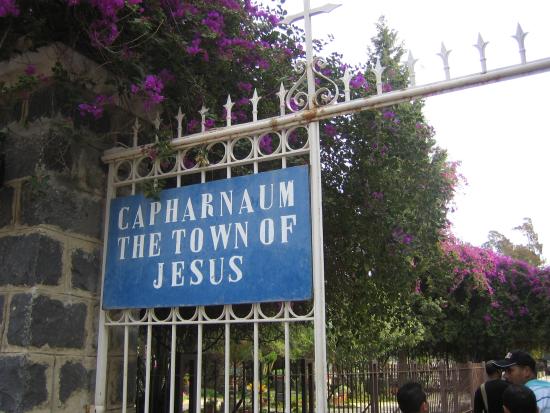Capernaum
Capernaum was a fishing village established during the time of the Hasmoneans, located on the northern shore of the Sea of Galilee. It had a population of about 1,500. Archaeological excavations have revealed two ancient synagogues built one over the other. A house turned into a church by the Byzantines is said to be the home of Saint Peter.
New Testament
The town is cited in all four gospels (Matthew 4:13, 8:5, 11:23, 17:24, Mark 1:21, 2:1, 9:33, Luke 4:23, 31,7:1, 10:15, John 2:12, 4:46, 6:17, 24,59) where it was reported to have been near the hometown of the apostles Simon Peter, Andrew, James and John, as well as the tax collector Matthew. One Sabbath, Jesus taught in the synagogue in Capernaum and healed a man who was possessed by an unclean spirit (Luke 4:31–36 and Mark 1:21–28). This story is notable for being the only one common between the gospels of Mark and Luke, but not contained in the gospel of Matthew (see Synoptic Gospels for more literary comparison between the gospels). Afterwards, he healed Simon Peter’s mother-in-law of a fever (Luke 4:38-39). According to Luke 7:1–10 and Matthew 8:5, it is also the place where Jesus healed the servant of a Roman centurion who had asked for his help. Capernaum is also the location of the healing of the paralytic lowered through the roof to reach Jesus reported in Mark 2:1–12, and Luke 5:17–26.
In Matthew 9:1 the town is referred to only as “his own city” and the narrative does not mention the paralytic being lowered through the roof. Most traditional biblical commentators assume that “his own city” means Capernaum because of the details which are common to the three synoptic gospels. although the writers of the Jamieson-Fausset-Brown Bible Commentary suggest that alternatively it could refer to Nazareth.
According to the Synoptic Gospels, Jesus selected this town as the center of his public ministry in Galilee after he left the small mountainous hamlet of Nazareth (Matthew 4:12–17). He also formally cursed the city, saying “you will be thrown down to Hades!” (Matthew 11:23) because of their lack of faith in him as the Messiah.
House of Peter
One block of homes, called by the Franciscan excavators the sacra insula or “holy insula” (“insula” refers to a block of homes around a courtyard) was found to have a complex history. Located between the synagogue and the lake shore, it was found near the front of a labyrinth of houses from many different periods. Three principal layers have been identified:
A group of private houses built around the 1st century BC which remained in use until the early 4th century.
The great transformation of one of the homes in the 4th century.
The octagonal church in the middle of the 5th century.
The excavators concluded that one house in the village was venerated as the house of Peter the fisherman as early as the mid-1st century, with two churches having been constructed over it (Loffreda, 1984).
Synagogue
The ruins of this building, among the oldest synagogues in the world, were identified by Charles William Wilson. The large, ornately carved, white building stones of the synagogue stood out prominently among the smaller, plain blocks of local black basalt used for the town’s other buildings, almost all residential. The synagogue was built almost entirely of white blocks of calcareous stone brought from distant quarries.
The building consists of four parts: the praying hall, the western patio, a southern balustrade and a small room at the northwest of the building. The praying hall measured 24.40 m by 18.65 m, with the southern face looking toward Jerusalem.
The internal walls were covered with painted plaster and fine stucco work found during the excavations. Watzinger, like Orfali, believed that there had been an upper floor reserved for women, with access by means of an external staircase located in the small room. But this opinion was not substantiated by the later excavations of the site.
The synagogue appears to have been built around the 4th or 5th century. Beneath the foundation of this synagogue lies another foundation made of basalt, and Loffreda suggests that this is the foundation of a synagogue from the 1st century, perhaps the one mentioned in the Gospels (Loffreda, 1974). Later excavation work was attempted underneath the synagogue floor, but while Loffreda claimed to have found a paved surface, others are of the opinion that this was an open, paved market area.
The ancient synagogue has two inscriptions, one in Greek and the other in Aramaic, that commemorates the benefactors that helped in the construction of the building. There are also carvings of five- and six-pointed stars and of palm trees.
Source : wikipedia
https://www.youtube.com/watch?v=yadlArGxjCY
https://www.youtube.com/watch?v=CzN7epLE1pE
Reviews



Rate this article